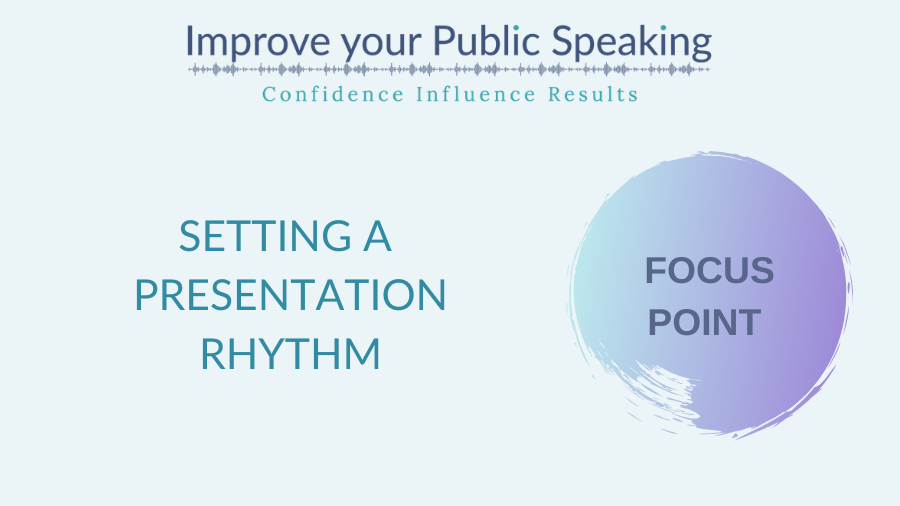
A good way to get your audience’s attention at the start of your talk is by setting a presentation rhythm. Lay out for them a plan about how your talk is going to unfold, and then follow that rhythm.
You’re basically giving an agenda, with rhythmic pace built into it. And it sounds simple, but I don’t often see it done.
The case for setting a presentation rhythm
Rhythm is primal. Our connection to it starts before birth with our mother’s heartbeat, and it’s an integral part of our voice, speech and communication. And we’ve been communicating using rhythm for thousands of years…From 8,000 year old drums found in Mesopotamia, to Inuit ones from Greenland dating back 4,500 years.
Rhythm is the force of life, constantly moving and evolving.
Dame Evelyn Glennie, percussionist

The rhythm section in an orchestra or band is powerful – it has the strength and control to over-ride what ever else is happening. It’s the underlying pulse which creates energy and drive – or loosens and stops it. So as speakers, when we set a presentation rhythm at the beginning and explain that rhythm upfront to the audience, they will happily lock-in and come along with us. I’ve also experienced this in my original training as a classical pianist; I used to perform professionally, and loved setting a rhythm that I chose, locking into it and feeling the audience come with me. That’s the magic of rhythmic entrainment.
How you do it
Tell them upfront what the rhythmic pace will be. For example:
“We have 45 minutes together, and I’ve got three modules for you. I’ll spend roughly ten minutes on each module with a break for questions after each one, finished by a summary and wrap-up.”
Or: “there are four items that we need to cover in the next hour.The first is going to be the longest – taking about 20 minutes – and I’m going to move through it at a good pace. So don’t worry that we’re going to go over, or run out of time. That’s the way I’ve planned it to work!”
Or: “I’ll give you a quick overview of the first agenda item – this should take less than five minutes. Then I’ll spend the rest of the presentation on the solutions part, followed by a quick Q and A, then wrap-up.”
When you do this, can you see the benefits for the audience?
- They feel taken care of – you’ve obviously considered their perspective
- If they tune out – and they will – they can easily slot back in to where you are
- They have a framework to follow – which rewards and satisfies their brain
Of course, as the speaker we then have to follow the rhythm we’ve set – so it does take practice, and knowing our content and timing. If we let the audience down on this one, it’s a worse look than not stating it in the first place!
This doesn’t mean of course that we have the same rhythm throughout our entire presentation. Our speech pace has to change throughout. Think of as like laying down a track: you’d start with the underlying pulse, the drum or percussion beat, then add the vocals with variation over the top. And the pulse will vary, depending on what we’re talking about and the different key points of our presentation.
If you’re open to thinking in a different way about your presentations, this quote might appeal:
A speech is poetry: cadence, rhythm, imagery, sweep! A speech reminds us that words, like children, have the power to make dance the dullest beanbag of a heart.”
Peggy Noonan, speechwriter for Ronald Reagan
If you did want to think more creatively about your presentation, you might like to think about it in terms of different styles of music, and the rhythms that those styles create. What type of music would you equate to your presentation? Does the style of music change as you progress?
It might sound a bit ‘out there’ but this can be a great way to see your presentation skills with fresh eyes. And it’s particularly relevant if you frequently have to present on the same topic in the same way. Anything you can do to keep some freshness for yourself is important.
I do this myself: any topic I regularly present on, I look at with a different view, and tweak something – even if it’s only small. This helps me to stay engaged myself. Because remember this: if you’re bored, your audience will definitely be bored!
These are blog articles for another day.
I’ve also written another brief article on creating a structure for your audience here.
Summary of setting a presentation rhythm
You’ll be taking care of your audience by setting an easy-to-follow rhythm for them; and you can make this work successfully if you know the timing and rhythm of your presentation in advance. It’s another level of presentation skills refinement: simple, but not always easy to do.
Best wishes with your presentations.

Comments (2)
Interesting, encouraging, and also clear !
A useful piece of work for one ones who are interested in the field !
Thanks Nuwan, I’m glad you enjoyed the article.